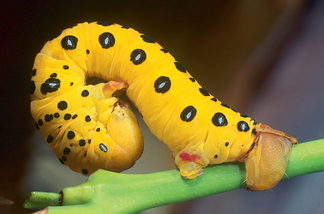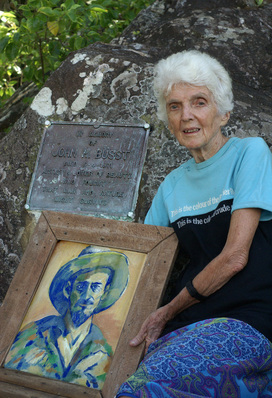Working on clearing the weeds which have so energetically sprung up in Wildwatch’s little patch of forest since the cyclone, and planting trees to replace those which fell, has provided excellent opportunities for quiet observation.

It is delightful to be surrounded by butterflies. There are the easily observed Cairns birdwing and the Ulysses butterfly, the birdwing relatively slow flying in comparison to the dancing, nervous Ulysses. But there is a myriad of smaller butterflies too, some easily identified, others still a mystery.
These two species have a most interesting relationship.
The moth butterfly lays its eggs near a green ants’ nest to allow the emerging caterpillars to crawl into the ants’ nest and eat the ant larvae. When the adult butterfly emerges from the pupa, it is covered in loose scales from the ants’ nest which allow it to escape, even though the ants attack it. A kind of armour for insects.
It is not obvious whether this is a true symbiotic (mutually beneficial) relationship but the butterfly certainly benefits and could not do without its green ant benefactors.
The moth butterfly is plump bodied and in repose its wings are light brown, with a dark brown patch on the forewing.
I was unable to put a name to a small but perfect white butterfly which settled nearby. Its wings had a furry texture and its legs were zebra striped in black and white. I was able to watch it for quite some time as it sat, apparently peaceful, on some tufted grass.
An interesting moth we often see flying above the low trees surrounding the house, often circling in groups, is Dysphania fenestrata, the four o’clock moth. It is easily identified by its dark patterned wings with see-through patches in them.
Its caterpillars are unmistakable, being large, bright yellow, with circular spots reminiscent of portholes on a ship along each side. They feed on the leaves of the corkwood and can strip a young tree completely. The tree always recovers. Interestingly, we have often observed adult moths flying around the caterpillars, as if they are in attendance.
So little is known about so many of the inhabitants in the wild world and observation so often seems to raise more questions than it answers.
One thing is certain. It offers fascination as well as beauty and time spent in simply looking is well rewarded.
+++

Mrs Thorsborne is a lifetime environmental warrior and her gentle commonsense and caring has been instrumental in helping to solve many dilemmas.
Hinchinbrook Island’s famous Thorsborne Trail, walked and enjoyed every year by visitors from all over the world, was named in recognition of her late husband Arthur’s dedication to the integrity of the environment
The beautiful migratory Torres Strait pigeon, so nearly hunted to extinction, owes much of its recovery to Margaret and Arthur Thorsborne. Its progress is still being monitored.
Margaret Thorsborne’s love for and understanding of the environment has long been viewed as a practical gift to the Australian people, and the generations to come.
Typically, she took time while she was in Brisbane to lobby for her beloved North Queensland and its wildlife affected in the wake of Cyclone Yasi.
Wildwatch is provided by the Tully branch of the Wildlife Preservation Society of Queensland: enquiries to 4066 5466 or 4066 5650. To contact the emergency 24-hour Wildcare rescue hotline, phone 4068 7272. Phone DERM on 1300 130 372 to report concerns about cassowaries and mahogany gliders.

